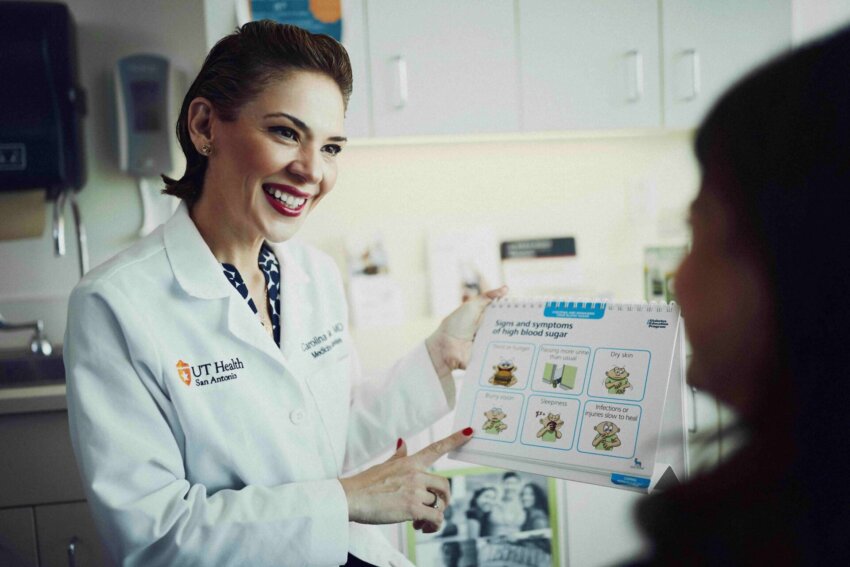Your A1C not high enough to be diabetes? It’s still serious
More than one out of three people have pre-diabetes, characterized by abnormal blood sugar levels not yet in the diabetes range – and yet associated with significant increases in eye, kidney and neuropathic diseases, and risk of cardiovascular death.
Moreover, the number of people with the condition is expected to double by 2030, with prevalence substantially higher in minority populations, including Hispanics. Both pre-diabetes and diabetes are considered global epidemics.
As pre-diabetes largely is underdiagnosed and undertreated, Carolina Solis-Herrera, MD, a physician-scientist, associate professor and chief of endocrinology at The University of Texas Health Science Center at San Antonio (UT Health San Antonio) has received a first-of-its-kind, $1.2 million award from Baptist Health Foundation of San Antonio to implement early intervention measures for the condition. It will serve a significant unmet need in the community.
“The goal is to establish pioneering and affordable treatment regimens for early intervention and treatment of pre-diabetes and obesity, with emphasis in the Hispanic population, that later can be spread throughout our community by establishing pre-diabetes clinics and stopping the progression of diabetes,” Solis-Herrera said.
“Additionally,” she said, “using sophisticated imaging and molecular technology, we aim to identify novel therapeutic targets to treat these disorders as we work toward a cure.”
“Baptist Health Foundation of San Antonio is honored and excited to be involved in Dr. Solis-Herrera’s work,” said Cody Knowlton, president and CEO of the foundation. “Diabetes is a pressing concern for so many people in our service area, and we pray that this study will have clear, impactful results that can improve the future health of our community.”
What indicates pre-diabetes?
Pre-diabetes is indicated by a “glycated hemoglobin blood test,” commonly known as an A1C test, that provides information on average levels of blood glucose, or blood sugar, over a previous two-to-three-month period. Results are reported as a percentage; the higher the percentage, the greater the risk of developing Type 2 diabetes, the most common form.
An A1C level of 5.7% to 6.4% indicates pre-diabetes, with a level of 6.5% or more indicating diabetes. A combination of lifestyle changes and medication can lead to a long-term prevention of progression to Type 2 diabetes. As it is, however, more than half of patients with pre-diabetes will develop Type 2 diabetes in their lifetimes.
More than 37 million Americans, or approximately one in 10, have Type 2 diabetes – and about one in five of those don’t know it. Diabetes is the main cause of blindness, amputation and dialysis worldwide, and in this population, cardiovascular events are the leading cause of death. The prevalence of Type 2 diabetes is significantly higher in Hispanics.
But pre-diabetes itself is considered a serious health condition, even though blood sugar levels are not high enough to be Type 2 diabetes. More than 96 million Americans have pre-diabetes, and an estimated 80% of those are not diagnosed. And yet pre-diabetes patients have a significantly higher risk of cardiovascular disease and death.
Risk factors for both pre-diabetes and Type 2 diabetes include obesity, sedentary lifestyle, family history and minority descent. More than 41% of Americans are classified as obese. And risk factors in San Antonio and South Texas are greater.
More than 65% of the population of greater San Antonio is Hispanic, and the prevalence of pre-diabetes and Type 2 diabetes here is significantly higher than the rest of the country. Bexar County has the highest Type 2 diabetes age-adjusted mortality rate in Texas, and each year, the cost of diagnosed Type 2 diabetes statewide is approximately $25.6 billion.
“Given the lack of early diagnosis and treatment, the cost of pre-diabetes and its complications is unknown, but can be expected to be much greater than with Type 2 diabetes,” Solis-Herrera said. “In addition, cost of treatment can be a barrier. Therefore, affordable alternatives are needed and will be identified through this study.”
While multiple studies have explored available therapies for Type 2 diabetes, she says, only recently has there been significant attention paid to pre-diabetes.
“Proactive detection and early intervention of pre-diabetes will significantly decrease the progression of diabetes, with a tremendously positive impact in our community,” Solis-Herrera said. “Moreover, by using state-of-the-art research technology, this study will be the first of its kind to utilize a combination of the latest pharmacological therapies and biomolecular tools, giving us a distinct advantage that will uniquely focus on our Hispanic population.”
If you are interested in participating in this clinical trial or to find out more about our other multiple trials, please call: 210-450-9059.


